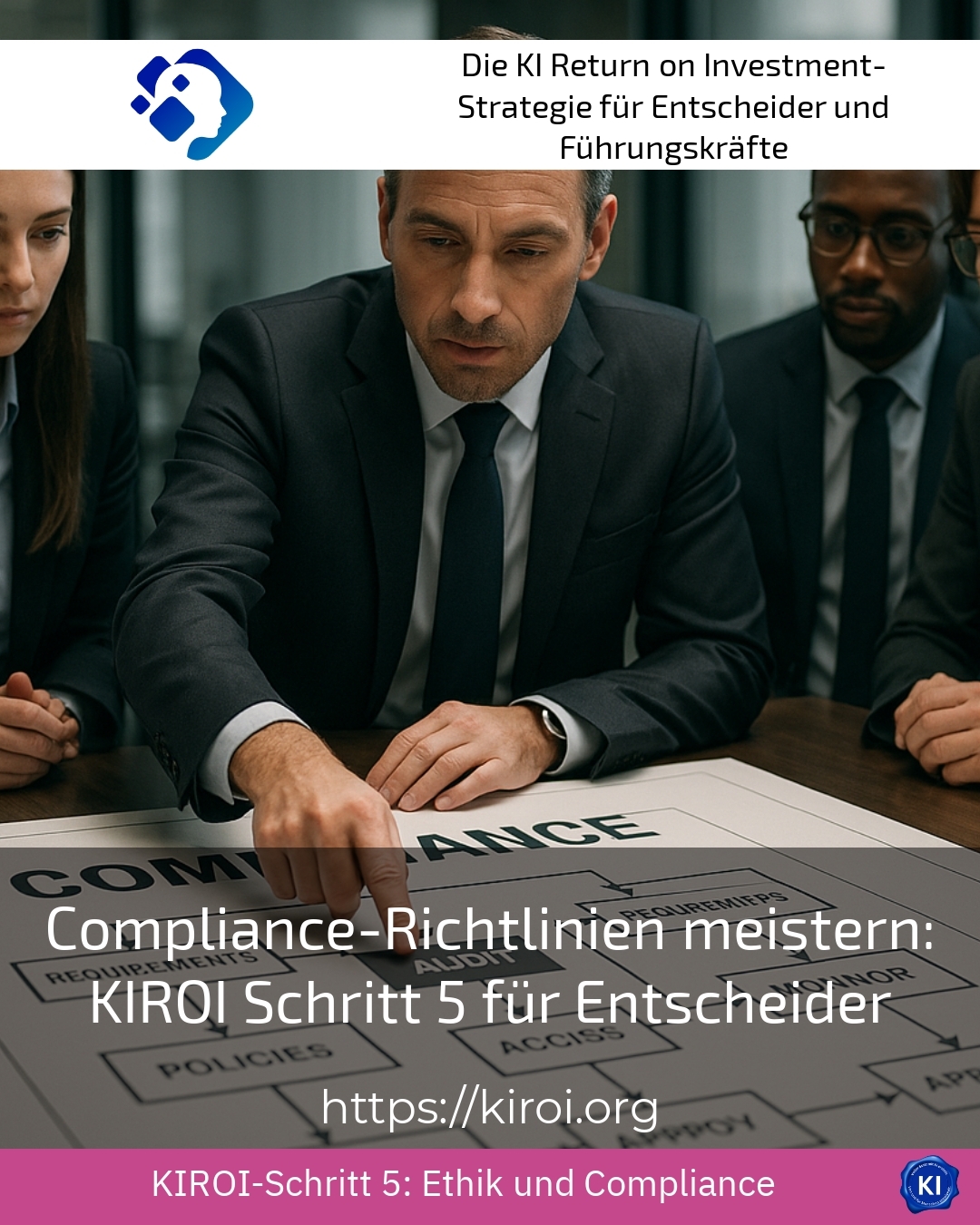Nowadays, it is essential for decision-makers to familiarise themselves with compliance guidelines. These guidelines help companies to consistently comply with legal requirements and internal regulations. KIROI Step 5 focuses on the effective implementation and support of projects relating to compliance guidelines. This is because project managers often ask themselves questions such as: How do I implement compliance guidelines sustainably? What specific measures help with compliance? And how can risks be minimised? This article helps those responsible to master these complex challenges in a practical way.
Ensuring compliance guidelines as a basis
Compliance guidelines form the foundation for legally compliant and ethically responsible corporate governance. It is not enough to simply define the guidelines. Rather, the decisive step is to integrate them into the organisation and anchor them there transparently. For example, a manufacturing company must ensure that its quality and environmental standards are implemented in accordance with the law, while in the financial sector the focus is often on data protection and money laundering prevention. In the IT sector, on the other hand, compliance guidelines on IT security and data protection are of great importance.
Practice shows that companies that formulate clear and comprehensible rules are much better at avoiding compliance gaps. In addition, regular training courses help to raise employees' awareness of compliance issues and support them in implementing specific behaviours.
BEST PRACTICE with one customer (name hidden due to NDA contract)
An internationally active medium-sized company in the mechanical engineering sector established a digital policy management system. This enabled it to standardise existing compliance guidelines and make them accessible to all employees via a user-friendly portal. At the same time, it introduced mandatory compliance workshops that were specifically tailored to the respective department and its risks. The result was a measurable reduction in errors and violations in the area of environmental protection and occupational safety.
KIROI Step 5: Successfully support compliance guidelines
The fifth step of the KIROI method for decision-makers is about not only nominally introducing compliance guidelines, but also understanding the entire process as a continuous accompanying project. Implementation alone is not enough - compliance management must be sustainable and constantly optimised.
In practical terms, this means for decision-makers:
- Involvement of all relevant stakeholders through transparent communication and training.
- Establishment of control mechanisms, such as regular audits or digital monitoring, in order to recognise breaches of guidelines at an early stage.
- Creating a culture that promotes openness to compliance issues and facilitates the reporting of grievances.
In practice, we often see that compliance risks increase when processes are digitalised. For example, when introducing new IT systems where data protection regulations need to be observed more closely. Decision-makers who accompany such projects with a focussed compliance perspective create trust and significantly increase legal certainty.
Best practice from the service industry
A large company from the service sector used KIROI Step 5 to re-establish its compliance guidelines for the prevention of corruption. Targeted workshops and individual coaching sessions for managers increased awareness of compliance issues. Such measures accompanied the systematic risk analysis and ensured that offences were significantly less frequent.
Practical tips for everyday practice
In everyday working life, KIROI Step 5 supports decision-makers in making compliance guidelines visible and comprehensible. Here are some ideas:
- Use simple and understandable language in your guidelines. This will increase acceptance among employees.
- Use digital tools to organise and document training and policy management.
- Rely on regular dialogue within the team to reduce inhibitions when reporting compliance violations.
For example, a retail company can ensure that its supply chain guidelines are consistently adhered to. In the healthcare sector, data protection is supported by standardised processes and suitable technology. And in the construction industry, checklists and on-site training help to implement safety and compliance guidelines.
Utilising compliance guidelines as a strategic opportunity
Compliance guidelines should not only be seen as a formal obligation, but also as an opportunity to sustainably improve the corporate culture and business processes. Managers often report positive effects when compliance is cultivated as an integral part of project management and corporate culture. This not only strengthens legal and operational security, but also the trust of customers, partners and employees.
BEST PRACTICE with one customer (name hidden due to NDA contract)
A logistics company used compliance guidelines as the basis for the development of sustainable supplier management. Targeted compliance training and monitoring tools made it possible to optimise processes and improve both environmental and social standards. Projects were not only implemented in accordance with the rules, but also more sustainably.
My analysis
From the decision-makers' point of view, compliance guidelines are more than just a bureaucratic obligation. They are a dynamic instrument that helps companies to master challenges in the regulatory environment and to live their own responsibility in the market. The support provided by methodically structured steps such as KIROI Step 5 helps decision-makers to implement compliance guidelines effectively and establish them in the long term. The combination of clear guidelines, continuous communication and practical support for all employees remains crucial.
Further links from the text above:
How to implement compliance guidelines effectively
Important aspects and best practices in compliance management
Efficient policy management: 5 tips against chaos
Compliance: definition, tasks, guidelines
Compliance guidelines - Company
Compliance rules: The top 5 guidelines for every company
For more information and if you have any questions, please contact Contact us or read more blog posts on the topic Artificial intelligence return on investment here.















